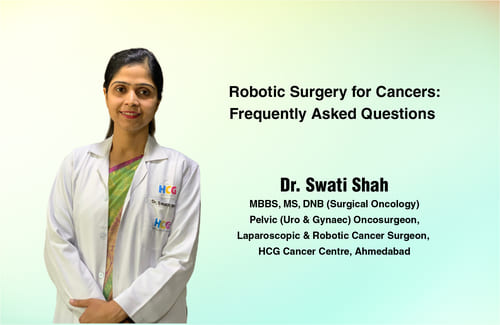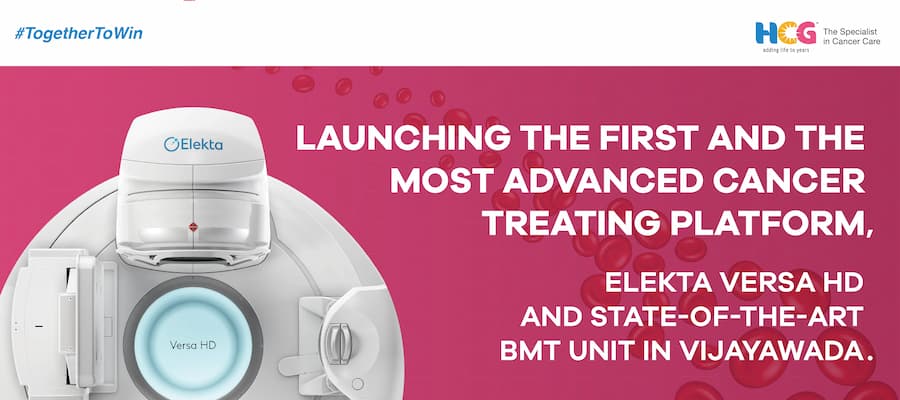
05 May, 2022

05 May, 2022
Robotic surgery is a type of minimally invasive surgery that uses robotic machinery to assist a surgeon in performing procedures while minimising patient trauma and recovery time. In cancer patients, robotic surgery may be used in place of traditional laparoscopy or open surgery to help remove the tumour.
Using robotic tools, doctors can carry out surgical procedures by using special cameras and wristed instruments. The procedures are thus more precise and cause less damage than the more conventional surgical methods.
Our doctors use robotic surgery to help remove hard-to-reach tumours, shorten surgery times, and reduce side effects for cancer patients who require surgery as part of their treatment.
Lets take a closer look at some of the most common questions people have about robotic surgery for cancer patients.
Robotic surgery or robot-assisted surgery is a form of minimally-invasive surgery that supports the surgical management of cancers with more precision, flexibility and control than those achieved through traditional surgical approaches.
At HCG, we use the high-end da Vinci Robotic Surgical System for performing robotic surgeries. The da Vinci Robotic Surgical System is primarily made of three components: the robotic arms that carry the surgical tools and a camera, a vision cart that provides the visual feedback and the viewing and control console where the surgeon sits.
A tiny video camera with three-dimensional optics and vision is carried by one of the robot arms. The other three robotic arms carry specialised surgical instruments and access the surgical field through small incisions less than an inch long.
The robotic arms use EndoWrist technology, which enables delicate arm movements that are not possible with human hands. The surgeon sits at the control console and directs the movements of these robotic arms, which are based on highly detailed, magnified images taken by a camera mounted on one of the robotic arms. These robotic arms can reach regions of the body that are normally unreachable using traditional methods.
Robotic surgeries come with a myriad of advantages for patients. Unlike open surgeries and other treatment modalities, robotic surgeries cause fewer treatment complications and thereby improve the chances of positive clinical outcomes, excellent survival rates and a better quality of life during and after the treatment.
The following are the potential advantages of robotic surgery:
Robotic surgery is not recommended for everyone. It is ideal for specific cancer cases depending on the stage of the disease, size of the tumour, location and the overall condition of the patient.
Robotic surgeries are recommended for the following cancers:
Gynaecological Cancers: Robotic surgery for gynaecological cancers helps in reducing blood loss during the surgery. Early-stage uterine cancers are largely treated with robotic surgeries.
Urological Cancers: Our centre houses highly-skilled and experienced robotic uro-oncologists who are well-versed in the management of various urological cancers.
The supreme precision factor of robotic surgeries supports the management of kidney cancers, bladder cancers, testicular cancers and prostate cancers. Robotic surgery is found to work extremely well for prostate cancers.
Gastrointestinal Cancers: Robotic surgery may also be recommended in the management of oesophagal cancers, colorectal cancers and pancreatic cancers.
Head and Neck Cancers: Robotic surgeries are also found to be helpful in the management of specific head and neck cancers.
Robotic surgeries are slightly expensive as compared to other surgical approaches. This is because high-end and latest equipment is used for the procedure, and the robotic surgeries are always performed by a team that is extensively trained and experienced. However, they can be cost-effective and deliver excellent value for money.
The benefits, such as shorter hospital stay, reduced risk of treatment-related complications, lowered risk of postoperative illness and most importantly, early return to activity, justify the cost of the procedure.
On the other hand, open surgeries are associated with blood loss, lengthy hospitalisations and increased risk of postoperative illnesses, which could lead to increased expenses or loss of earnings. Therefore, it is safe to say that robotic surgeries are ultimately cost-saving for patients in the long run.
Robotic surgeries are relatively less painful when compared to open surgeries. In general, patients experience fewer treatment-related complications; this supports shorter hospital stays, early functional recovery and nerve preservation.
If patients do experience severe pain, they can get in touch with the expert team, who can help with appropriate medical interventions that ease the pain.
Robotic surgery is one of the advanced treatment approaches available for cancers. The precision and the safety that it comes with have made cancer surgeries significantly tolerable for patients. At HCG, we have a large pool of skilled robotic surgeons who have enabled superior cancer care support to patients with simpler to complex cancer cases.
This article is contributed by Dr. Swati Shah, Pelvic (Uro & Gynaec) Oncosurgeon, Laparoscopic & Robotic Cancer Surgeon, HCG Cancer Centre, Ahmedabad
